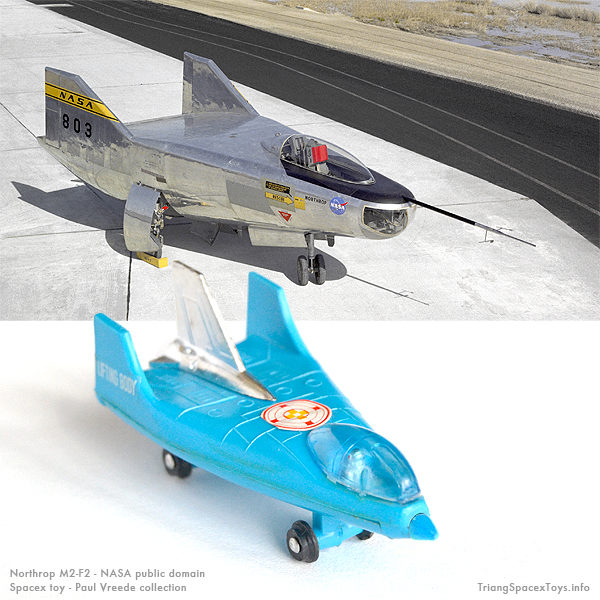
The Spacex Lifting Body is a rather generic representation of such a craft. It most closely resembles the Northrop M2-F2 (above), but has a more rounded upper surface, a larger canopy placed more towards the front and less wide, more curved tails - the latter looking more like those from a later concept by Aerojet (shown on the Rescue Craft origin page).
The central tail must be based on that of the Northrop HL-10 (below), which has a similar central bulge underneath the tail as well. The later M2-F3 also had a central tail, but this only first flew in June 1970, by which time the Spacex toy was already in production.
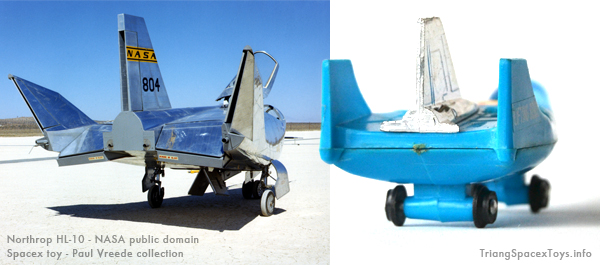
As is clear from its name, a lifting body is an aircraft without wings, where the shape of the body itself provides the lift to keep it in the air. For space flight, lifting bodies would have the advantage over "ballistic" capsules like Mercury, Gemini and Apollo in that they could allow controlled flight after re-entry, where a capsule could only drop down on parachutes within its ballistic trajectory.
The lifting bodies were developed at the NASA Flight Research Center at Edwards AFB in the Californian Mojave Desert (later called Dryden and recently renamed after Neil Armstrong who also was a test pilot there). They started as a bottom-up project by engineers and test-pilots, initially with no official funding and on a shoestring budget eked out of facility maintenance funds.
Prior to 1962, a number of engineers had been intrigued with lifting body dynamics, until one of them, Dale Reed (1), built a balsa-wood scale model to try it in flight. Armed with the model and home movie footage his wife had shot of his tests (2), Reed and his fellow-engineer Dick Eldredge first got test pilot Milt Thompson and then other engineers at Edwards on board to build a full-sized glider. And luckily, they had an ally in their boss Paul Bickle, who believed in his engineers getting time for flying technology research and who thought this project was right for doing so.
The result was the M2-F1 glider, built in four months for a mere $30,000 and dubbed "the Flying Bathtub", having a wooden shell (built by a local sailplane craftsman) over a tubular metal carriage and fitted with aluminium tails. To tow it for ground-testing and low-level flight, the team procured "the only government-owned hot-rod convertible", a powerful Pontiac on drag racing slicks with a modified engine that could get the M2-F1 up to 110 mph (177 kph) in 30 seconds!
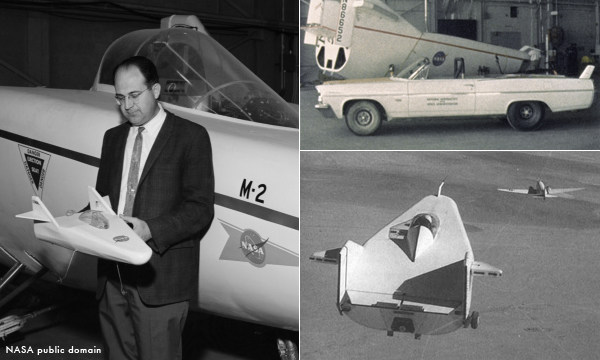
Left: Dale Reed with the M2-F1 model that started it all.
Right: the Pontiac tow car and M2-F1 being towed by a US Navy Dakota.
From March 1963 the M1-F2 was first ground-tested by towing it along, then in a wind tunnel at NASA Ames, where enthusiastic supporters of the project found time to slot it into their busy schedule. To speed things up and because it didn't have remote control, M1-F2 was tested in the tunnel with various engineers actually sitting in its cockpit! After making some necessary rectifications, the next step was to get the Bathtub up to altitude.
This is where scepticism from other NASA officials at Edwards now came in. First an ejector seat had to be fitted, and next, Paul Bickle had to take sole responsibility (effectively laying his career on the line) to authorise flights despite the veto of his research chief. But up she went on 16 August 1963, towed by an R4D (the US Navy name for what the Army called a C-47, the British called a Dakota and the airlines call a DC-3), and with success: after first performing a practice landing manoevre at altitude, Milt Thompson glided her down in a steep dive before pulling up for a perfect touchdown.
1963 ended with a number of prominent test pilots incl Chuck Yeager getting a flight, with unanimous praise for the lifting body's performance. The next two years saw extensive testing, until one of the test pilots, shorter than most, was found upside down behind the tow plane because he couldn't see either the tow plane or the horizon from his cockpit. Doing a half-roll to come in for landing, damage was sustained to the undercarriage on his second flight and Paul Bickle had to step in to end towed flight and ground the glider.
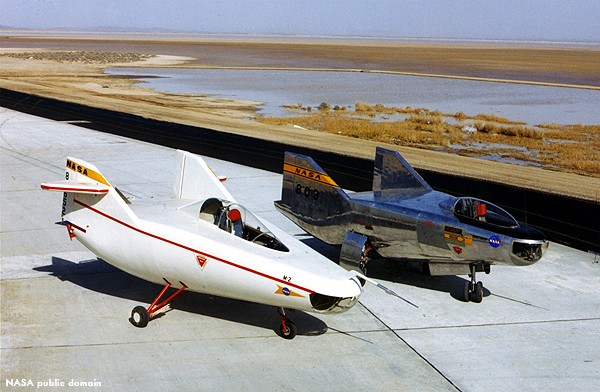
The original M2-F1 lifting body (left) with its all-metal successor the M2-F2 (right)
But the M2-F1 had done it's job and done it well: proven that a lifting body could effectively work, and generate a huge amount of interest in the concept, both in the popular press, within the aerospace industry and within NASA. A more official programme was now set up, with an official request for proposals. Northrop made the best bid, so got the contract of building a metal version of Reed's Bathtub which became the M2-F2. Next to this, a second design that had been developed at NASA Langley was also built, being the HL-10. Both would be taken up by a B-52 bomber and released from altitude.
By re-using components from other Northrop designs, and through a very close and efficient no-fuss collaboration with the NASA team, Northrop delivered the two lifting bodies on time and on budget - costing $1.2 million apiece, less than a tenth of what such a project could have cost. As an example of close cooperation, a weight-distribution problem on the M2-F2 was solved by Northrop and NASA engineers sitting down together and coming up with increasing nose weight through reinforcing the cockpit structure - a solution that would turn out to be most beneficial for safety too.
Sadly, and despite extensive testing under tow, in the wind tunnel and while attached to the B-52, the metal lifting bodies didn't meet with immediate success. The HL-10 was grounded after its first, very unstable gliding flight, so Langley engineers could investigate. The M2-F2 was also proving "angry" in flight, oscillating from side to side in descent though the test pilots did manage to control her flight sufficiently to continue testing. Until disaster occurred on the 17th flight when test pilot Bruce Peterson overcame an oscillation in flight leaving him further along the runway than intended, then was distracted just long enough by a rescue helicopter flying too close that he lowered the landing gear a fraction too late. He crashed on landing, the M2-F2 rolling in the dust at 250 mph / 400 kph (the footage of which was eventually used for the opening titles of "The Six Billion Dollar Man" (3)).
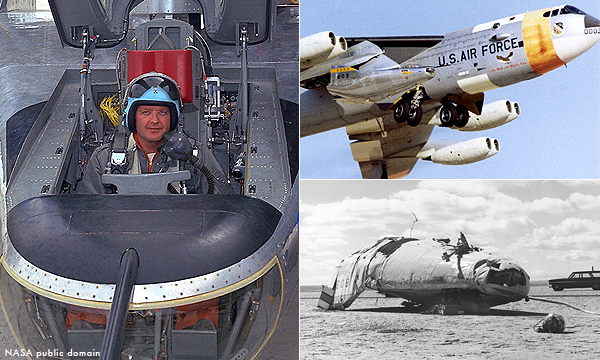
Left: Milt Thompson in the M2-F2 cockpit.
Right: M2-F2 going up under a B-52 and after crashing on 10 May 1967
Peterson survived the crash (although seriously injured and eventually losing vision in one eye), and surprisingly, so did the M2-F2. Which was rebuilt as the M2-F3, and eventually fitted with a central tail which cleared the stability problem. Long before that happened however, the HL-10 had its problems solved as well, and would go on to make successful flights, under rocket power from the end of 1968, and first going supersonic in May 1969.
A third design was added to the programme, the X24 built by Martin Marietta as a re-entry test vehicle for the US Air Force, which would eventually be fitted with a long pointed nose to become the X-24B in late 1972. The pointed nose and extra winglets would make a re-entry vehicle that could manoevre far more off its trajectory path than the lifting bodies could. After testing, the X-24B flew in late 1973 (gliding at first but under power within a couple of months) and turned out to be a very good aircraft, handling well at all speeds. It continued flying until the lifting body programme was ended in late 1975.
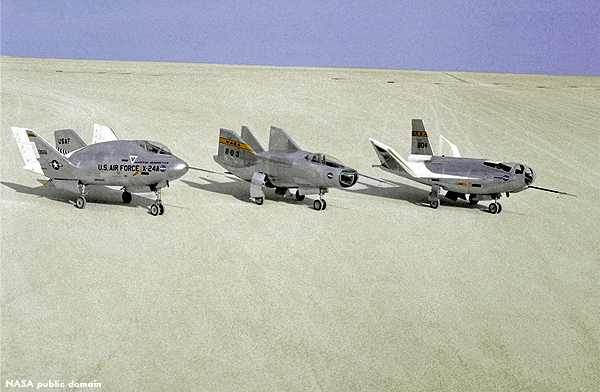
L to r: Martin X24A, Northrop M2-F3 and HL-10
Other than producing a huge body of test data, what the lifting bodies promised and the X-24B effectively proved during dedicated tests, was that the upcoming Space Shuttle could accurately land, horizontally (as opposed to a vertical landing by a space capsule) and without requiring engines (thus saving weight and space and increasing the Shuttle's carrying capacity). A wonderful result for a programme that started with just one man and his model aircraft.
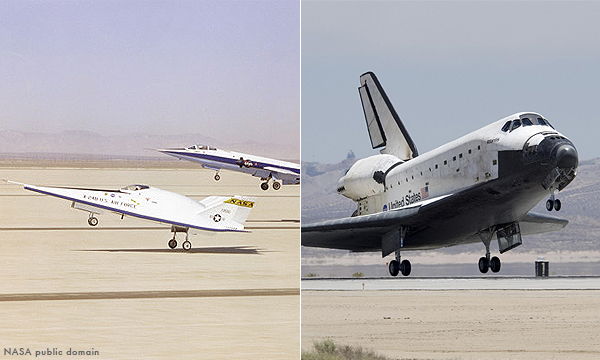
Left: The Martin X-24B (with F-104 chase plane)
Right: the lifting body legacy: a Space Shuttle touching down after gliding in from re-entry.
External links open in new windows - just close them to get back here.
1: As the last surviving person to be involved in the project from the start, Dale Reed ended up writing a superb story about it, available on the NASA history site. I've largely based my entry above on this document, grateful for such excellent source material.
Much later, I also came across a comprehensive and well-illustrated account by Robert Hoey who was involved on the Air Force side (pdf file). back to text
2: A short 15-second clip of the model in flight is available in the NASA Movie Collection.
back to text
3: If you look closely at the real footage in the opening title sequence, you'll see that the lifting body being dropped is actually the HL-10 (triangular shape with outward-sloping fins and central tail). The rest of the footage is indeed the M2-F2. Better footage of the crash is also on Youtube, as is footage of successful flights. Although of less than optimal quality, there's also a nice contemporary documentary. back to text